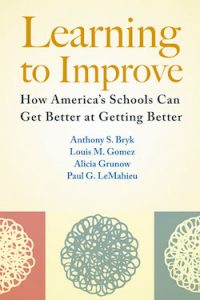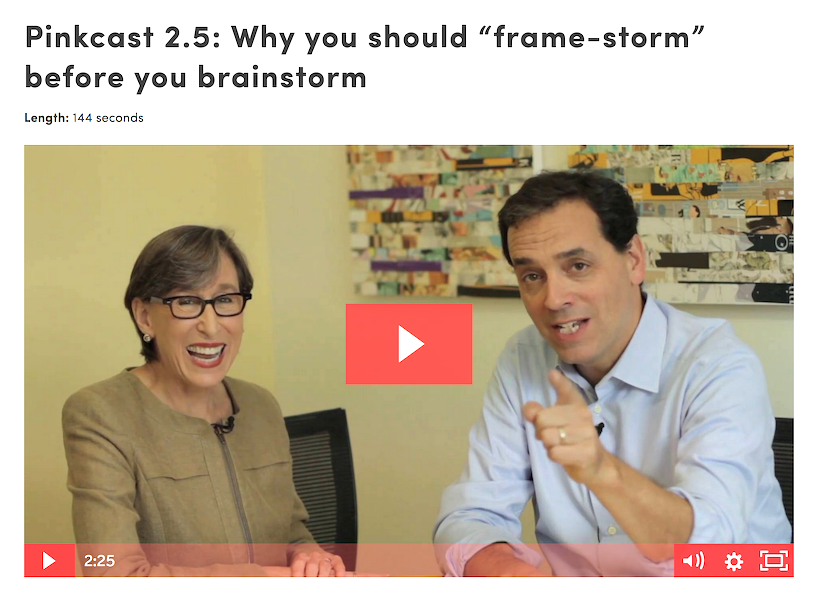We can, whenever and wherever we choose, successfully teach all children whose schooling is of interest to us; we already know more than we need to do that. —Ron Edmonds
 Many of us are familiar with this quote. And, if you are like me, you find it haunting. Haunting because it keeps you up at night thinking about the students who are falling through the cracks.
Many of us are familiar with this quote. And, if you are like me, you find it haunting. Haunting because it keeps you up at night thinking about the students who are falling through the cracks.
Haunting because you chose this profession to change lives. Haunting because even though you see progress occurring, you don’t feel that it is fast enough to reach all children. And, haunting because if we know what needs to be done, why aren’t we doing it?
 These recurrent hauntings led me to read the book, Learning to Improve: How America’s Schools Can Get Better at Getting Better, by Anthony Bryk, et al. (Harvard Education Press, 2015). Bryk is the president of the Carnegie Foundation for the Advancement of Teaching and a long-time education researcher.
These recurrent hauntings led me to read the book, Learning to Improve: How America’s Schools Can Get Better at Getting Better, by Anthony Bryk, et al. (Harvard Education Press, 2015). Bryk is the president of the Carnegie Foundation for the Advancement of Teaching and a long-time education researcher.
I bought the book a year ago, intending to read it, but other priorities got in its way. I picked it up again recently after Jackie Walsh called with a provocative opening statement: “I now know why Carnegie didn’t select your proposal to speak at their conference.”
Intrigued, I wanted to hear more. She told me about the book and I embarrassingly admitted to having a copy. So she asked me to turn to p. 150 in the book:
The commitment of participants to a specific measurable aim is a distinguishing feature of NICs [Networked Improvement Communities]. In comparison, learning communities, communities of practice, and some forms of researcher-practitioner partnerships often describe their efforts as ‘learning together.’ Typically, these communities are convened around some common interest coupled with social affinity. Participants may engage in compelling discussions about a common problem and share reflections about things they have tried. However, they do not commit to achieving a specific improvement nor measure progress toward it.”
Bingo. Our networks don’t meet the definition of NICs. But should they be? During that phone call with Jackie, we both pondered this question. I agreed to read the book so we could discuss it further, and I’m looking forward to that dialogue. In the meantime, the purpose of this blog post is to share what I’m learning about NICs and to engage you, the reader, in a conversation about it.
What are Networked Improvement Communities?
According to Bryk and his co-authors, NICs are “intentionally designed social organizations, and participants have distinct roles, responsibilities and norms for membership (p. 144).”
NICs are organized around a specific challenge that members want to address. NICs are:

Tony Bryk Focused on a well-specified common aim.
- Guided by a deep understanding of the problem, the system that produces it, and a shared working theory to improve it.
- Disciplined by the methods of improvement research to develop, test, and refine interventions.
- Organized to accelerate the diffusion of these interventions out into the field and support their effective integration into varied educational contexts (p. 144).
Our networks do focus on a specific area, and we do expect participants to learn and act on what they are learning. But, clearly, we don’t have a formal process for action, nor do we consistently ask participants to collect and share data.
The NIC Principles
If we wanted to experiment with a NIC, we’d pay attention to six important improvement principles. Summarized, these principles include:
►Problem-specific and user-centered work
►Focused on the “variation in performance”
►Seeking to understand the system that produces the current results
►Measuring progress or lack thereof
►Driving improvement through “disciplined inquiry”
►Accelerating learning through NICs (pp. 12-17)
These six principles are the backbone of the book, with a chapter explaining each one. Throughout the book, the authors highlight actual case studies – some in education, others in business.
What NICs seek to avoid is what the authors call “solutionitis,” the tendency to jump to the “how” before addressing the “what” and “why.” To illustrate solutionitis, the authors tell the story of the creation of the Swiffer mop. To recover lost market share and make floor-cleaning “better,” the designers at Proctor and Gamble were tasked with creating a better mop” (p. 22).
 Thanks to out-of-the-box thinking, however, they learned that the problem was not actually about making floor-cleaning better, but making it easier. How did the designers come to that conclusion? They spent time watching people mop floors and listened to their complaints and needs. They learned about unwieldy mops and the nasty job of rinsing mops in water that got dirtier and dirtier as the mopping continued. So, instead of creating a better soap, the created a better mopping system…and the rest is history.
Thanks to out-of-the-box thinking, however, they learned that the problem was not actually about making floor-cleaning better, but making it easier. How did the designers come to that conclusion? They spent time watching people mop floors and listened to their complaints and needs. They learned about unwieldy mops and the nasty job of rinsing mops in water that got dirtier and dirtier as the mopping continued. So, instead of creating a better soap, the created a better mopping system…and the rest is history.
How does this apply to education? Bryk and colleagues suggest that “school reform, like the creation of Swiffer, is an act of design” (p. 26), and there is a specific process required to successfully improve. It begins with what they call the “golden rule: observe and consult people on the ground who know the most about the problem.”
Our Own Story about “Solutionitis”
In a recent blog post, Emily Strickland and I touched on this concept when we wrote about the Powerful Conversations “Restart” Network. Participants in this year’s Wiregrass+ Network were almost all new to the PCN, due to educator turnover and a variety of other reasons.
This posed a unique opportunity to rethink what we could do with a “new to us” network. Reflecting on what seemed to be the “two-steps forward, one-step back” results from our focus on student-engaged assessment, I wondered whether we had a mild case of “solutionitis.”
In our first iteration, had we made certain assumptions about the readiness and dispositions of PCN participants when we decided that we could introduce the entire process of student-engaged assessment in one year?
What if we slowed down, really listened to participants, and focused first on the “why” and the “what” before moving so quickly to the “how?”
Good questions that were worth pursuing.
 So, with the consent of our district contacts, we decided to differentiate the design for this one network, beginning anew with our same guiding text, Leaders of Their Own Learning. Looking back at the original design, I realized that we had not initially spent nearly enough time on the “what” and the “why” of student-engaged assessment.
So, with the consent of our district contacts, we decided to differentiate the design for this one network, beginning anew with our same guiding text, Leaders of Their Own Learning. Looking back at the original design, I realized that we had not initially spent nearly enough time on the “what” and the “why” of student-engaged assessment.
At our first meeting this fall, this assumption seemed to be validated, as participants seemed much more comfortable with the concepts and willing to try them out.
While this is not an exact comparison to what NICs do, it did get me thinking: What if one of our networks—or a smaller group of educators—were willing to become a NIC?
An ABPC-supported NIC?
To simplify what is quite a complex process, NICs consider three important questions (p. 114):
►1. What specifically are we trying to accomplish?
►2. What change might we introduce and why?
►3. How will we know that a change is actually an improvement?
If we were to create a NIC, we’d follow a three-step process: (1) Identify the current capacity of participants (and those who might be involved in the identified problem); (2) Assess organizational capacity and human capabilities; and (3) Assess the current status of “good will and the willingness of those affected to engage.”
And, this would be just the initial steps. There is much more to implementing a NIC than I’ve mentioned in this short blog. I wonder if Bryk’s concept of “current capacity” might include the capacity to resist jumping to solutions before investigating, listening, and the “frame-storming” that Daniel Pink and Stanford professor Tina Seelig talk about in this recent Pinkcast (click below and watch on Dan’s webpage).
As I write this, I’m reminded of the power of our Networks and the value the work brings to all those who participate—and the adults and children who benefit from the learning when network participants return to their school and districts.
Might a NIC help us have even greater impact? Might it reduce the number of nights that many of us are haunted by Ron Edmonds’ powerful insight, made more than three decades ago? I wonder…


0 Comments on "Could NIC Help Schools Seal the Learning Cracks?"